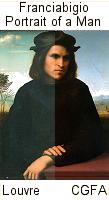| 1. | Be Aware of the Actual Artwork Size.
Artworks are usually larger than they appear in web images, sometimes vastly larger, and their size is an important element of how the viewer experiences them. Chuck Close's paintings of faces, for example are typically on the order of nine feet high. Whenever you look closely at an artwork online, it's a good practice to note its actual dimensions in real life.
Tip: If you want to view exactly how large a work is in real life, visit ActualSizer.com. This is a tool that displays an artwork at its actual size, taking into account your specific monitor size and screen resolution.
|
| 2. |
 Be Aware of the Limits of Reproduction.
Be Aware of the Limits of Reproduction.
There are many sources of error between the museum wall and your monitor. Lighting, photographing, printing, scanning and image "enhancement" can all drastically affect how the final version of the image appears online. Take a look at 2 scans of any artwork from 2 different sources (see example at right), and you will likely see a remarkable difference.
And this caveat isn't limited to reproductions: The last time I visited the Louvre in Paris, I was quite shocked at the poor lighting in many galleries, due to a combination of fluorescent and natural lighting, and by how much the appearance of the art was affected by the constantly shifting light from the skylights.
|
| 3. | Look for the Enlargement.
Many art museum websites have an enlargement or "zoom" facility, but the fact is sometimes far from obvious. Make a point of always looking for a little magnfying-glass or plus-sign icon. Also, these features frequently require Java or Flash, so be sure your browser has them enabled.
|
| 4. | Look Beyond Art Museums.
Museums are usually the most definitive source of information about their own artworks, but they don't necessarily have the best scans online. Many online image archives boast art reproductions that are the equal of any museum. Artportal.org's Images page has a list of some of the biggest and best image archives.
|
| 5. | Look Deeper.
Many museum websites include background information about an artwork or an artist, known in the business as "interpretive text". This is information literally designed to help you interpret what you are seeing. I highly recommend you read whatever you can about any work you think is significant. The more you know, the deeper your understanding and enjoyment of the work will be.
|
| |
| 6. | Maximize Your Viewing Area.
To get the greatest possible amount of viewing area from your browser, press PF11 to go into full-screen mode, and PF11 to go back to regular mode.
|
| 7. | Check Your Monitor
I didn't realize until recently how differently two monitors can display the same image. We had two LCD monitors in our house, both by the same manufacturer, and one was rendering artworks much darker than the other and, more significantly, with much less detail visible altogether. I eventually sat down and played with their built-in settings side-by-side, and was eventually able to calibrate them properly. If you want to check your own monitor, here are two good sites that start out simple but take the subject as deep as you'd like. (Both sites also have links to info about printer calibration)
ePaperPress Monitor Calibration
Norman Koren Photography
|
| 8. | How to Save an Image to Your Hard Drive.
I can't get into the legalities of republishing found images on the web or anywhere else, but it is normally allowed to save or print any web image for personal enjoyment or research.
Method 1: Right-click on the image, select "Save Picture As...", and save it to the directory of your choice.
Method 2 (right-click is blocked): From the drop-down menu, select "File/Save As...", and save the whole web page to disk. Make sure you specify you want to save the "Web Page, Complete".
Method 3 (image is displayed within Java or Flash, or is otherwise protected): If all else fails, simply take a screenshot by clicking [alt][shift]-PrintScrn. Then paste the screenshot into a graphics program by clicking [ctrl]-v. If you don't have a proper graphics program, you can even paste it into Microsoft Word.
| | 9. | Beware of Web Images Displayed at an Incorrect Resolution.
I frequently notice websites that display images at a different size from the actual height and width in pixels of the image file. The symptoms to look for are (1) if artificially enlarged, the image looks kind of pixellated or "blocky", (2) if artificially reduced, the lines of the image often appear rough and jagged, and (3) the image may even be stretched horizontally or vertically. If you encounter this, I suggest you view the image directly in your browser, to see if it looks better that way.
In Firefox, Safari and Opera, you can usually view the image easily by right-clicking on it and selecting "View Image" (or "Open Image"). In Explorer, you have to right-click on the image and bring up "Properties", then copy the image URL into your browser's URL bar and press Enter.
|
| 10. | Get a Cropping/Editing/Image Ehancement Tool.
This is a handy thing to have if you want to enhance any images you save for personal use off of the Internet. It also gives you more control over how the image should appear if you want to set it as your desktop background. The easiest and most flexible free tool I am aware if is IrfanView, which is a decent editor and a great viewer.
|
|